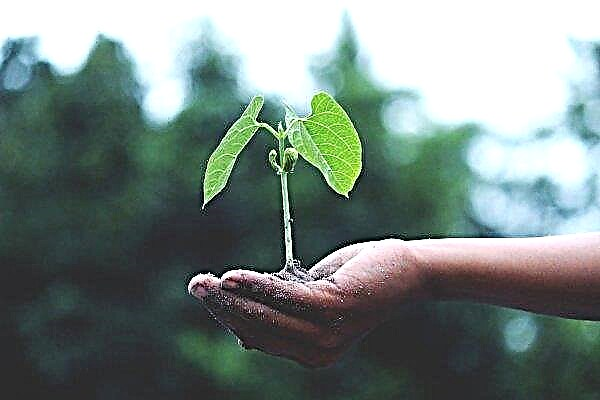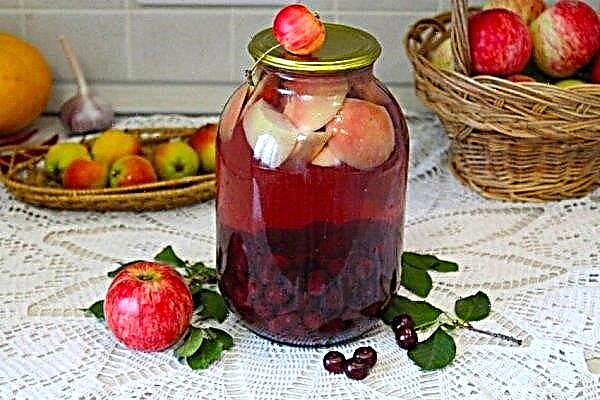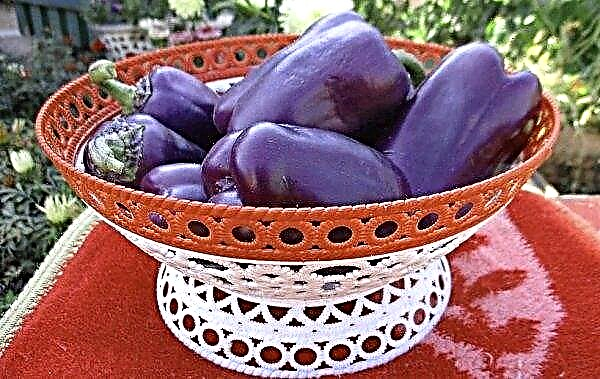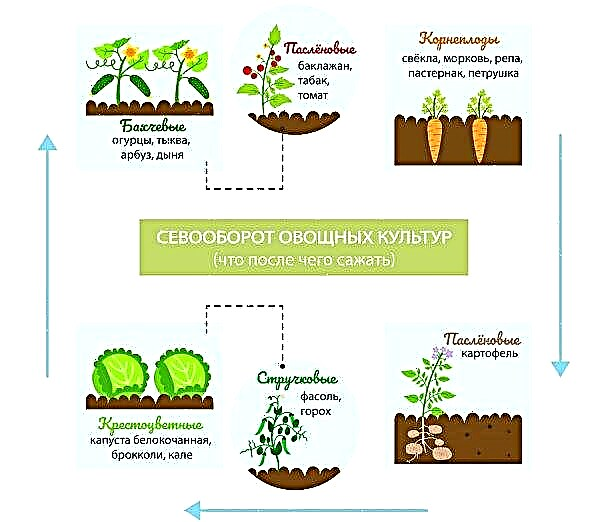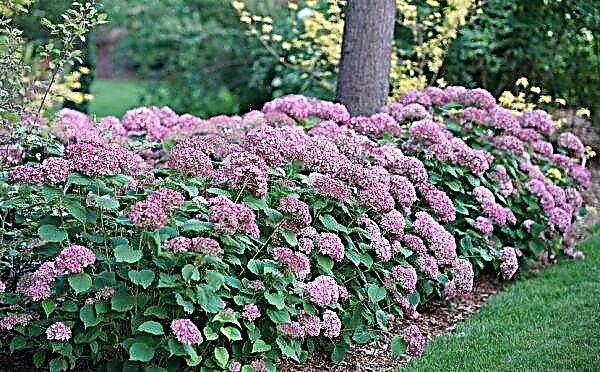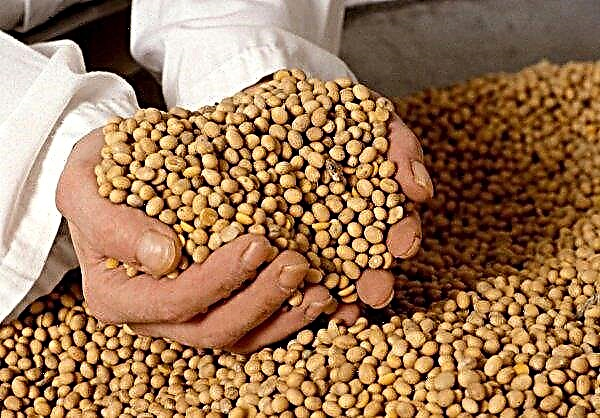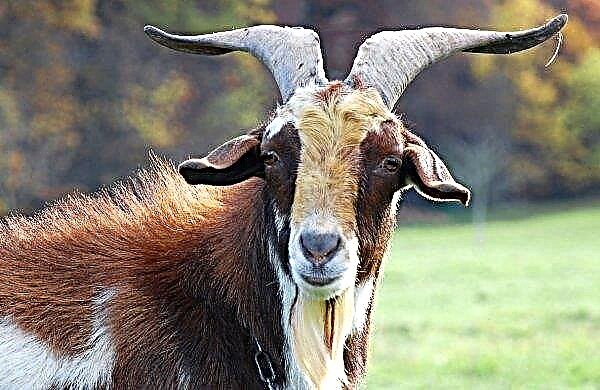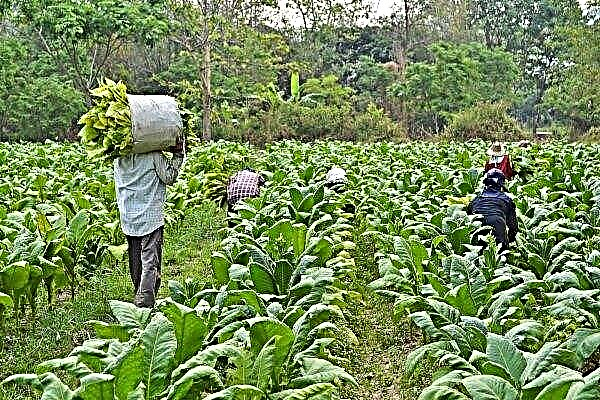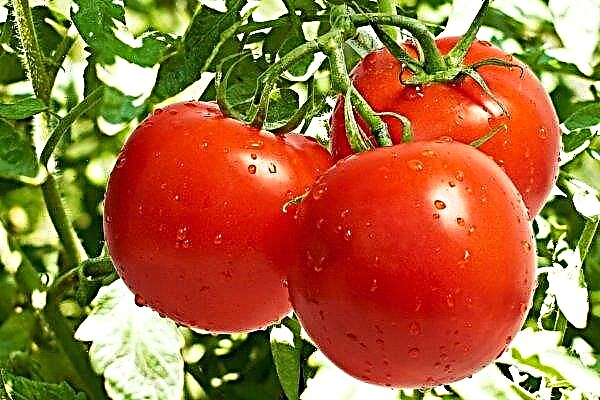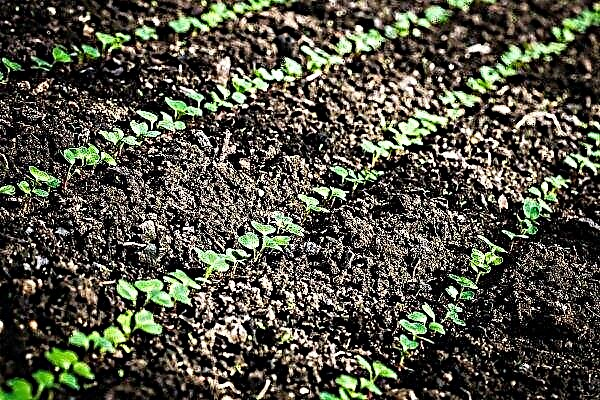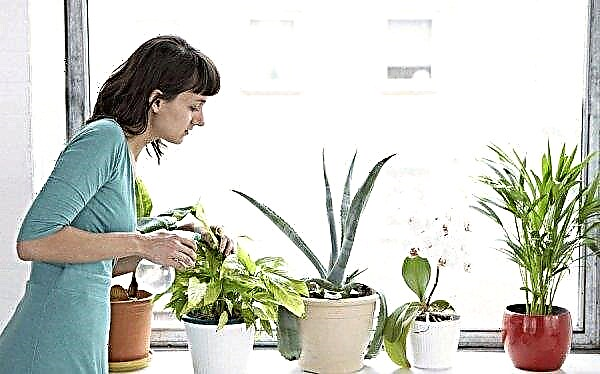Among tomatoes, the most valuable are the varieties characterized by high productivity, good taste and resistance to solanaceous diseases. All these characteristics are possessed by the Tsar Bell tomato variety. Read more about its features, as well as cultivation rules below.
Characterization and description of the variety
The tomato variety Tsar Bell is the result of amateur selection. It is included in the state registry of the Russian Federation with a recommendation for cultivation in open areas and in greenhouse conditions. Bushes are semi-determinant type, compact. Adult specimens reach a height of 80–100 cm. The bushiness of the bush is weak. Leaf plates are small, densely structured, dark green in color. Flowers are formed every 2 leaves. Plants are resistant to most diseases characteristic of solanaceous, but subject to all agricultural rules and crop rotation. The variety tolerates temperature differences well.
Did you know? Essential oils of tomato leaves are actively used in perfumes and are aphrodisiacs.
The fruits are large, weighing 500-800 g. In connection with this feature of the variety, it will be necessary to pinch and tie up the bushes so that they do not break under the yoke of tomatoes. Tomatoes that emerged from the first ovary are much larger than subsequent ones. Fruits can have a pear-shaped or rounded shape. Their surface is characterized by weak ribbing in the area of attachment to the peduncle. The color of the ripe fruit is deep red. The skin is dense, not prone to cracking. The pulp on the cut is red, juicy, fleshy, has a pleasant taste with pronounced sweetness. Productivity from 1 m² is 18 kg. Fruits are great for:
Fruits are great for:
- fresh use;
- additions to the first and second courses;
- cooking spicy sauces, ketchups, lecho.
Pros and cons of the variety
- pros
- large fruits of high commercial quality;
- high level of productivity;
- disease resistance;
- high percentage of seed germination;
- resistance to lower temperatures.
- Minuses
- the need to form a bush and garter, even with its small dimensions;
- exactingness to top dressing, since large-fruited ovaries require increased amounts of nutrients;
- the fruits are not suitable for canning in general.
Optimal growing time
The tomato variety Tsar Bell is grown in seedlings. Sowing seeds for seedlings should be carried out:
- in the beginning of March - for the southern regions;
- in the beginning of April - for the central strip and the northern regions.

The basic rules of growing
To get the maximum benefit from growing the variety in question, you must follow the basic rules of agricultural technology. Seeds do not need to be decontaminated before planting. They are just soaked in a growth stimulator. In this regard, the Epin drug will be quite good. Its use allows you to accelerate enzymatic reactions and stimulate protein synthesis.
The drug can be used not only in the phase of seed germination, but also for fertilizing seedlings as a first top dressing. To soak the seeds in 100 ml of water, add 2 drops of the substance. The seed is soaked for 2-4 hours. For seedlings, it is necessary to prepare a light moisture-permeable soil.
Important! The main active element of "Epina" is quickly destroyed by direct sunlight, so it is better to carry out various treatments using it in the evening.
You can use a universal soil mixture for seedlings or independently combine in equal proportions:
- peat;
- sand;
- deciduous humus.

Growing seedlings
For planting seeds, you can use:
- general capacities - in this case it will be necessary to pick in the stage of having 1 full leaf (not to be confused with cotyledon);
- separate plastic containers - when using this option, picking is not required, and landing in the ground will be carried out by the transshipment method;
- in separate peat containers - transplanting at the stage of vegetation seedlings is not required, and plants are planted in the ground with the container (after a while it rots in the soil and provides additional root nutrition).
In seeds filled with soil, the seeds are planted to a depth of 1 cm and sprinkled with coarse-grained sand. 1-2 seeds are planted in separate containers, in general, furrows are made at a distance of 5 cm from each other and seeds are placed in them with an interval of 3-5 cm. After this, the containers are covered with glass or polyethylene (transparent) and put into a dark room for 1 –2 weeks, where the air temperature is maintained within +23 ... + 27 ° С. Throughout the entire period before the appearance of the first seedlings, the plantings are aired every day for 15 minutes, while simultaneously assessing the state of the soil and, if necessary, moistening it by spraying it with warm (+ 30 ° C) water.
Did you know? Juicy pulp of tomato fruits not only does not lose its beneficial qualities during heat treatment, but also increases them. After 2 minutes of cooking, the content of the antioxidant lycopene, which prevents the progression of cancer cells, in the juice rises by a third.
With the advent of seedlings, seedlings are put on well-lit window sills and the cover is removed. Air temperature is reduced by 5 degrees. Humidity is maintained within 70%, soil moisture - 50%. Plants need to provide high-quality lighting - the optimal daylight hours for seedlings should be 12-14 hours. With the advent of the first true leaf, plants from common containers are transplanted into separate ones, deepening them to cotyledonous leaves, and after 2-3 days they are fed. Plants from individual containers begin to feed as soon as the first leaf unfolds. For the first time, seedlings are watered with Epina solution. The solution is made at the rate of 1 ml of the drug per 5 liters of water. The liquid is sprayed from the spray bottle and onto the surface of the soil. 1.5 weeks after the first feeding, a second is carried out. At this stage, a solution with manure is used. You can take any available excrement. Manure is bred in a proportion of 1:10.
Plants from individual containers begin to feed as soon as the first leaf unfolds. For the first time, seedlings are watered with Epina solution. The solution is made at the rate of 1 ml of the drug per 5 liters of water. The liquid is sprayed from the spray bottle and onto the surface of the soil. 1.5 weeks after the first feeding, a second is carried out. At this stage, a solution with manure is used. You can take any available excrement. Manure is bred in a proportion of 1:10.
For each plant, 100 ml are applied under the root. Throughout the entire period of growth, the temperature is gradually reduced by 0.5 degrees. 2 weeks before planting, the temperature is made as close as possible to the ambient temperature on the street and begin to set seedlings in the open air: first for 4 hours in the morning, gradually increasing the time interval. By the time of transplantation, plants should spend 24 hours outdoors.
Treatment of a plot for planting seedlings
For planting tomatoes, you need to choose a well-lit place, with a low occurrence of groundwater (at least 1.5–2 m). It is also worth considering the rules of crop rotation. Do not plant tomatoes after solanaceous. Good precursors for this crop are siderat plants (mustard, legumes, grains), as well as cabbage, onions, and garlic. The site is cleaned of plant debris in the fall and dug up to a depth of 20 cm. After this, a 1% solution of copper or iron sulfate is disinfected. After a week, fertilize the soil with humus or manure, applying 10 kg per 1 m², and superphosphate - 500 g / 1 m². To improve the air permeability of the soil, 10 kg of sand per 1 m² can be added. After that, the earth is again dug up onto the bayonet of a shovel. In the spring, similar digging manipulations are carried out. At the spring stage of preparation, the soil is disinfected with Fitosporin, following the instructions, and after a week, compost or rotted manure is introduced. Instead of Fitosporin, wood ash can be embedded in the soil at 300–500 g per 1 m².
After a week, fertilize the soil with humus or manure, applying 10 kg per 1 m², and superphosphate - 500 g / 1 m². To improve the air permeability of the soil, 10 kg of sand per 1 m² can be added. After that, the earth is again dug up onto the bayonet of a shovel. In the spring, similar digging manipulations are carried out. At the spring stage of preparation, the soil is disinfected with Fitosporin, following the instructions, and after a week, compost or rotted manure is introduced. Instead of Fitosporin, wood ash can be embedded in the soil at 300–500 g per 1 m².
Important! When using wood ash as a disinfectant, manure is not used, i.e. this substance neutralizes nitrogen contained in excrement. Ashes are best combined with compost.
Seedling Planting Technology
Diving seedlings into the ground is carried out in late May or early June, in greenhouses - in April or early May. On 1 m² it is permissible to place no more than 3 plants. The planting pattern of tomatoes is 40 × 50 cm. A few days before planting, seedlings are not watered. Humidification of the soil in tanks is carried out 1.5 hours before planting. It is much easier to work with peat tanks. For transplantation, simply dig holes that are suitable in size and place containers with plants in them, then compact the soil around the main stem with your hands and mulch it with compost. Plants are carefully removed from individual plastic containers with an earthen lump. Plants are carefully removed from common boxes using a long spatula or spatula. To do this, the soil is cut into squares, in the center of which the plants are localized, and then the inventory is buried in the slots to the full depth of the pot. Carefully dig up the soil and take out the seedlings along with a lump of earth. When planting, the plants are buried to cotyledon leaves. Near the holes immediately establish support and fix the plants.
Plants are carefully removed from individual plastic containers with an earthen lump. Plants are carefully removed from common boxes using a long spatula or spatula. To do this, the soil is cut into squares, in the center of which the plants are localized, and then the inventory is buried in the slots to the full depth of the pot. Carefully dig up the soil and take out the seedlings along with a lump of earth. When planting, the plants are buried to cotyledon leaves. Near the holes immediately establish support and fix the plants.
Features of the care for the variety Tsar Bell
The variety under consideration must be provided with proper nutrition and hydration to enable plants to form a powerful ground part. Do not forget about additional agricultural activities, which play a large role in the prevention of diseases and pests.
Fertilizers and watering
Humidification of the soil is carried out once every 6 days with warm water (+ 30 ° C). Soil moisture should be within 50%, i.e. rather moist, but not marshy. Each plant should account for 2-3 liters of fluid. Water is brought under the root, trying not to spray it on the ground part of the bushes. For this, a watering can with an elongated nose is perfect or you can organize a tape system with drip irrigation. Top dressing is applied 3-4 times for the entire season. An example diagram is as follows:
An example diagram is as follows:
- 10-14 days after disembarkation - Epina solution (1 ml / 5 l of water / 10 m²).
- Before flowering - 1 tbsp. l ash on a glass of compost under each bush.
- At the time of fruit setting - spraying on a sheet with a solution of ash (cook, as for disinfecting the soil) + a solution with yeast under the root (add 10 g of yeast + 1 tbsp of sugar per 10 liters of water, leave for 24 hours and strain). For each plant, 0.5 liters of ash and 1 liter of yeast are consumed.
- At the stage of active fruiting - yeast solution infused with nettles (do according to the above instructions, only with the addition of a plant element, and insist 7 days).
Important! When spraying on a sheet, in the morning, it is necessary to carry out not only watering, but also spraying with clean water to prevent clogging of pores and the appearance of sunburn.
Pasynkovka and formation of a bush
The tomato variety Tsar Bell needs formative pruning and pinching. These procedures prevent the development of diseases and increase the fertility of plants. Bushes can be formed in 1, 2 and 3 stems. In the first case, when side shoots appear, they are immediately removed, in the second - 1 powerful side shoot is left, in the third - 2 shoots. Manipulations are carried out with a disinfected sharp knife or clippers. The shoots are cut without leaving stumps. Slices are dusted with wood ash or activated carbon. Every 2 weeks, and sometimes even more often, stepchildren should be removed - shoots that are competitors for the main stems, which begin to form in large numbers at the beginning of flowering from the leaf sinuses. The formation of stepsons continues throughout the growing season, so they will have to be removed at intervals of 1 time in 1-2 weeks. Stepsons are removed when they reach a length of 2-3 cm, a maximum of 5 cm. Additional shoots can be formed not only in the axils of the leaves, but also from the formed brushes with fruits, as well as in the lower part of the bush - all of them must be removed.
Every 2 weeks, and sometimes even more often, stepchildren should be removed - shoots that are competitors for the main stems, which begin to form in large numbers at the beginning of flowering from the leaf sinuses. The formation of stepsons continues throughout the growing season, so they will have to be removed at intervals of 1 time in 1-2 weeks. Stepsons are removed when they reach a length of 2-3 cm, a maximum of 5 cm. Additional shoots can be formed not only in the axils of the leaves, but also from the formed brushes with fruits, as well as in the lower part of the bush - all of them must be removed.
Soil cultivation and weeding
In order for the roots to receive a sufficient amount of oxygen, plants need careful loosening in the near-trunk circle and row spacing. The procedure is carried out 12-24 hours after moistening the soil. In the near-stem circle, the soil is loosened to a depth of 5 cm, in rows between rows - 10 cm. In parallel with loosening, weeds are removed so that they do not take away food from the tomatoes. After aeration, it is advisable to mulch the soil with compost. This will provide additional nutrition, help maintain moisture in the heat and protect against the spread of pests that settle in the upper layers of the soil.
This will provide additional nutrition, help maintain moisture in the heat and protect against the spread of pests that settle in the upper layers of the soil.
Diseases and pests and their prevention
The variety is highly resistant to most diseases, however, in the absence of adequate care, they can still undergo late blight. When the first signs of this disease appear, it is necessary to remove the infected parts of the plants and spray them with a 1% solution of copper sulfate, and also adjust the moisture in the soil by adding peat mixed with ash to the beds (for 10 kg of peat - 500 g of ash).
Other fungal diseases are very rare. As a prevention of the appearance of fungi, plants are sprayed with Fitosporin according to the instructions.
Of the pests for the variety in question are dangerous:
- Colorado beetle - it will help eliminate the drug "Aktara", diluted according to the instructions;
- the bear - destroyed with the help of Medvetoks (granules are buried in the soil along the entire perimeter of the garden).

Harvesting and storage rules
Tomatoes begin to be harvested as they mature on the bushes to enable the development of a green ovary. Cut the fruit with scissors along with the stem. If the brush has fully ripened and brown specimens, it is completely cut off. Unripe fruits ripen quickly when cut. If the crop is used within 2 days, it is stored at room temperature, laid out in one layer down by the stalk in a dark room.
Did you know? The main component of tomato is water. Its content in fruits reaches 95%.
If necessary, keep the crop fresh longer, the tomatoes are laid out in the same way and provide a temperature within +6 ... + 10 ° С. As such, they retain their qualities for 1–2 weeks, depending on the degree of maturity at the time of collection. The tomato variety Tsar Bell is one of the most promising for cultivation in any region. It meets all quality standards and is relatively unpretentious in care.

